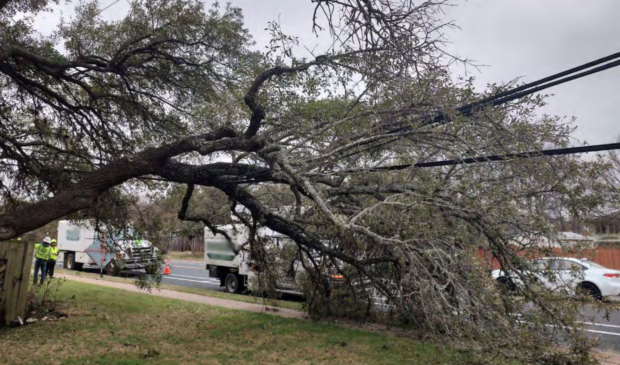Report finds widespread action needed to prepare city for future weather emergencies
Wednesday, October 4, 2023 by
Chad Swiatecki The city has received dozens of steps for staff at all levels to take to reduce the impact of future weather emergencies. The full after-action report for the February 2023 winter storm evaluates problems experienced during the freeze that disrupted power and other city services for over a week in some areas.
A memo released yesterday outlines some of the findings.
The after-action report identifies the improvements needed in six areas related to emergency management: communication, planning and preparedness, operational coordination, resource and asset management, technology and infrastructure, and shelter management.
The memo from interim Assistant City Manager Bruce Mills says the city can begin implementing the many recommendations after the detailed corrective action plan is delivered in December.
Communication needs include creating a plan with new requirements for before and during an emergency, spelling out communication plans between staff from city departments and emergency teams, smoothing technology and planning incompatibilities between different public agencies, and increasing the city’s data-sharing capacity to improve flow of information at all times. Other communication improvements include finding ways to communicate with residents outside of digital platforms, preparing scripted messaging for various emergency scenarios, enabling the use of AM/FM and ham radio for widespread communication and looking into other “no tech” options, equipping the 311 service for usage in emergencies, and alerting residents to shelter options during emergencies.
Recommendations for planning and preparedness included making a detailed list of various shelter types for different populations, offering training and education about preparation for disasters, evaluating how to help medically vulnerable people during emergencies, improving city departments’ plans for continuing operations in times of crisis, and ensuring the safety of utility crews working to restore service during prolonged outages. Other needed steps include creating a standard city/county plan for clearing rights of way, providing education on tree care for homeowners, and standardizing roles and needed skills for volunteer help during emergencies.
Operational coordination recommendations included improving software and practices for managing communications and requiring training in those areas, creating a citywide messaging tool for all city employees, reaching out to neighborhood groups to increase preparedness, identifying the staff needed during various emergency scenarios, cross-referencing planning documents between emergency crews and departmental staff, and implementing and practicing emergency preparedness steps. The report also calls for reviewing mass care plans for public health needs, developing standard operating procedures for staffing needs in an emergency, and training elected officials on response and recovery protocols.
Resource and asset management steps include documenting the skills and training of all city and county staff, creating compensation plans for staffing during an emergency, improving documentation of employees’ work availability and means of communication, establishing budgets for future disasters, including purchasing capabilities in emergency response teams, reviewing safety requirements for contractors, and making first responder facilities a priority for installing backup generators. The report also recommended creating security plans for shelters, finding ways to first use shelters with generators and room for relief operations, standardizing the services available at shelters, making backup power sources for traffic signals more robust, establishing assistance for parks facilities, and establishing a plan for cost recovery with state and federal agencies.
For technology and infrastructure, the recommendations include improving technology for maps reflecting service availability during emergencies, creating a priority plan for managing traffic signal disruptions, looking for technology that sends an alert when a traffic signal is out, standardizing communication tools and other technologies across agencies and departments, improving service to help non-English speakers on digital platforms, and creating a standard map reflecting the state of disaster-related data.
Shelter management recommendations included cataloguing the shelter availability throughout the area and “hardening” those structures with backup power and staff coordination, finding a way to balance speedy intake with offering needed special services, improving training for shelter management staff, studying best practices for population flow and availability of shelters with planned messaging to residents, educating and planning for assisting the elderly during emergencies, and creating training for citywide disaster scenarios. The report also called on the city to identify case workers and physicians for needed response, create a transportation plan for getting people to shelters and address the needs of animal shelters during emergencies.
The Austin Monitor’s work is made possible by donations from the community. Though our reporting covers donors from time to time, we are careful to keep business and editorial efforts separate while maintaining transparency. A complete list of donors is available here, and our code of ethics is explained here.
You're a community leader
And we’re honored you look to us for serious, in-depth news. You know a strong community needs local and dedicated watchdog reporting. We’re here for you and that won’t change. Now will you take the powerful next step and support our nonprofit news organization?






